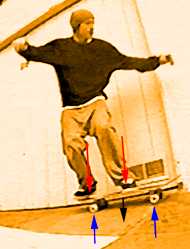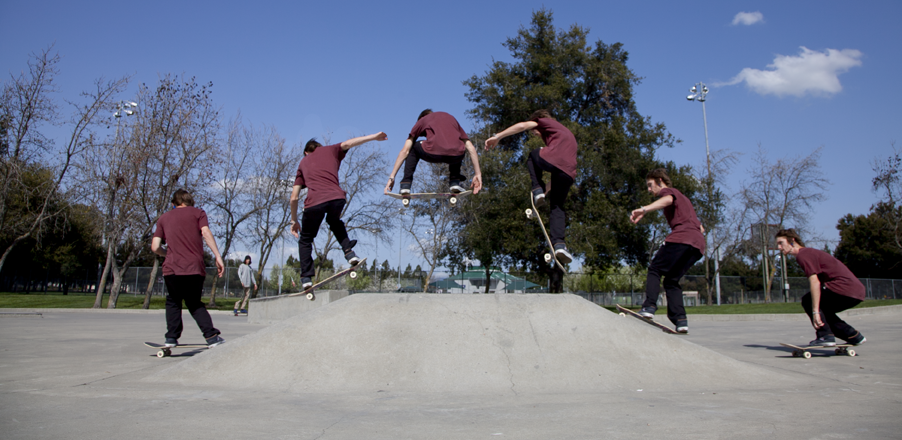Jumping: the Ollie
Frontside Forces and Fakie Flight: The Physics of Skateboarding Tricks (continued...)
Invented in the late 1970s by Alan "Ollie" Gelfand, the ollie has become a skateboarding fundamental, the basis for many other more complicated tricks.
In its simplest form, the ollie is a jumping technique that allows skaters to hop over obstacles and onto curbs, etc. What's so amazing about the ollie is the way the skateboard seems to stick to the skater's feet in midair. Seeing pictures of skaters performing soaring 4-foot ollies, many people assume that the board is somehow attached to the skater's feet. It's not. What's even more amazing about the ollie is that to get the skateboard to jump up, the skater pushes down on the board! The secret to this paradoxical maneuver is rotation around multiple axes. Let's take a closer look.
Forces in the Ollie
Just before a skater performs an
ollie
, there are three forces acting on the skateboard. One of these forces is the weight of the rider, shown here with two
red arrows
. Another is the force of gravity on the board itself, shown with a small
black arrow
. Finally,
blue arrows
show the force of the ground pushing up on the skateboard. These three forces balance out to zero. With no net force, the skateboard doesn't accelerate, but rolls along at a constant speed.
Notice that the skater is crouching down. A low center of mass will be crucial to getting a high jump. (Don't believe it? Stand perfectly straight and try jumping without crouching . . . you didn't get very high, did you?) Now let's follow the changing forces that go into making an ollie.


The skater accelerates himself upward by explosively straightening his legs and raising his arms. During the jump, his rear foot exerts a much greater force on the tail of the board than his front foot does on the nose, causing the board to pivot counterclockwise about the rear wheel.
As the tail strikes the ground, the ground exerts a large upward force on the tail. The result of this upward force is that the board bounces up and begins to pivot clockwise, this time around its center of mass.
With the board now completely in the air, the skater slides his front foot forward, using the friction between his foot and the rough surface of the board to drag the board upward even higher.
The skater begins to push his front foot down, raising the rear wheels and leveling out the board. Meanwhile, he lifts his rear leg to get it out of the way of the rising tail of the board. If he times this motion perfectly, his rear foot and the rear of the board rise in perfect unison, seemingly "stuck" together.
The board is now level at its maximum height. With both feet touching the board, the skater and board begin to fall together under the influence of gravity.
Gravity eventually wins out and the skater bends his legs to absorb the the impact of the landing.
